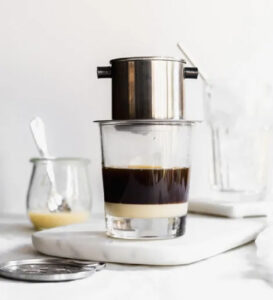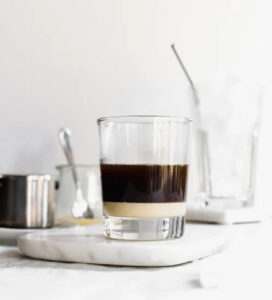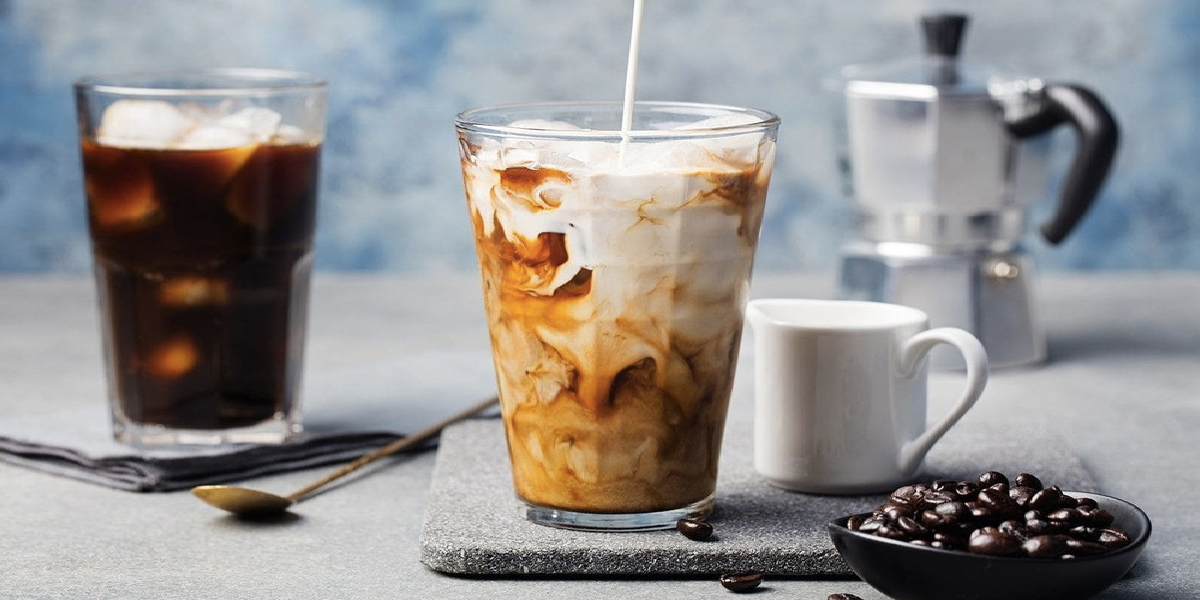Cà-Phê Sữa đá (Vietnamese Iced with Condensed Milk Coffee)
Calvin P. Tran
There’s nothing more simple than a cup of good coffee until you’ve had Vietnamese-style coffee. For the popular Vietnamese Iced Coffee recipe, strong coffee is slow brewed and served with sweetened condensed milk and ice.
If you’ve been to a Vietnamese phở restaurant, you’ll probably have seen someone order Cà Phê Sữa đá (Vietnamese coffee). It is served with the coffee slowly dripping through a stainless steel filter (phin), condensed milk on the bottom, and a tall glass of ice.
HISTORY OF COFFEE IN VIETNAM
Coffee was first introduced to Vietnam in 1857 by a French Catholic priest. The land was cultivated into coffee plantations.
Most of the coffee produced in Vietnam comes from the Robusta variety of coffee beans rather than the more commonly known Arabica.
Robusta coffee beans are not considered as high-quality as Arabica coffee beans because they are much more bitter and are used as a filler for instant coffee. However, Robusta is a hardier variety less susceptible to disease and yields larger crops.
HOW TO PREPARE VIETNAMESE COFFEE
What makes Vietnamese coffee unique is the method in which it is prepared.
Medium-coarse ground, dark roast coffee is added to a small stainless steel drip filter (a Cafe Phin). Hot water is poured over the top, and the coffee slowly drips through the filter into the cup.
The resulting coffee is strong and is poured over ice before serving. Because the coffee is strong, a little bit goes a long way.
HOW THE VIETNAMESE COFFEE PHIN WORKS 
What makes the Vietnamese coffee phin filter different than a pour-over is that the phin consists of 2 parts: a bottom metal cylindrical “cup” with perforations as well as a top disc with perforations that screws into the bottom “cup.” The coarse-ground coffee is placed into the bottom “cup” and is pressed when the top disc is screwed in with a utensil such as a spoon. The trick is finding the right balance between tightening the disc too tightly (no coffee can drip through), versus having the disc too loose (weak coffee, light brown water). 
To judge if I have tightened my phin correctly, I will pour a little hot water into it (after tightening). If the water doesn’t drip through, it must be loosened. If it drips through too fast, then it needs to be tightened.
Once I am sure that the water is dripping at the proper, slow, and steady rate, then I pour all of the remaining water into the phin, cover it, and let it drip away.
VARIATIONS OF VIETNAMESE COFFEE
- Cà-Phê đá — Just dark roast Vietnamese coffee and ice.
- Cà-Phê Sữa đá — a popular way of preparing Vietnamese coffee, with the addition of sweetened condensed milk. This is usually the coffee people refer to when speaking about Vietnamese coffee.
- Bạc Xỉu – is essentially the same drink, except the proportion of condensed milk is much more than the coffee. Suitable for people who enjoy their coffee on the sweeter side.
- Cà-Phê Trứng — Vietnamese whipped egg coffee which originated in Hanoi. Egg yolks are beaten with coffee, milk, and sugar, producing a rich, foamy drink reminiscent of eggnog.
All of these drinks can be served hot or cold with ice.
HOW TO MAKE THIS VIETNAMESE ICED COFFEE RECIPE Making Vietnamese iced coffee is quite simple once you get the hang of working with the coffee phin.
Making Vietnamese iced coffee is quite simple once you get the hang of working with the coffee phin.
I drip my hot coffee into a heat-resistant glass into which I have put my sweetened condensed milk. The hot coffee softens the sweetened condensed milk, making it easy to stir together when the coffee has finished dripping.
Then, the mixture gets poured into a tall glass with ice!
Vietnamese coffee is a drink enjoyed at a leisurely pace due to its slow drip. It’s one of my favorite pick-me-ups that I can make at home.
Try this simple Cà Phê Sữa đá — Vietnamese iced coffee with condensed milk — it’s a great way to cool down on a hot, humid summer’s day.


Leave a Reply